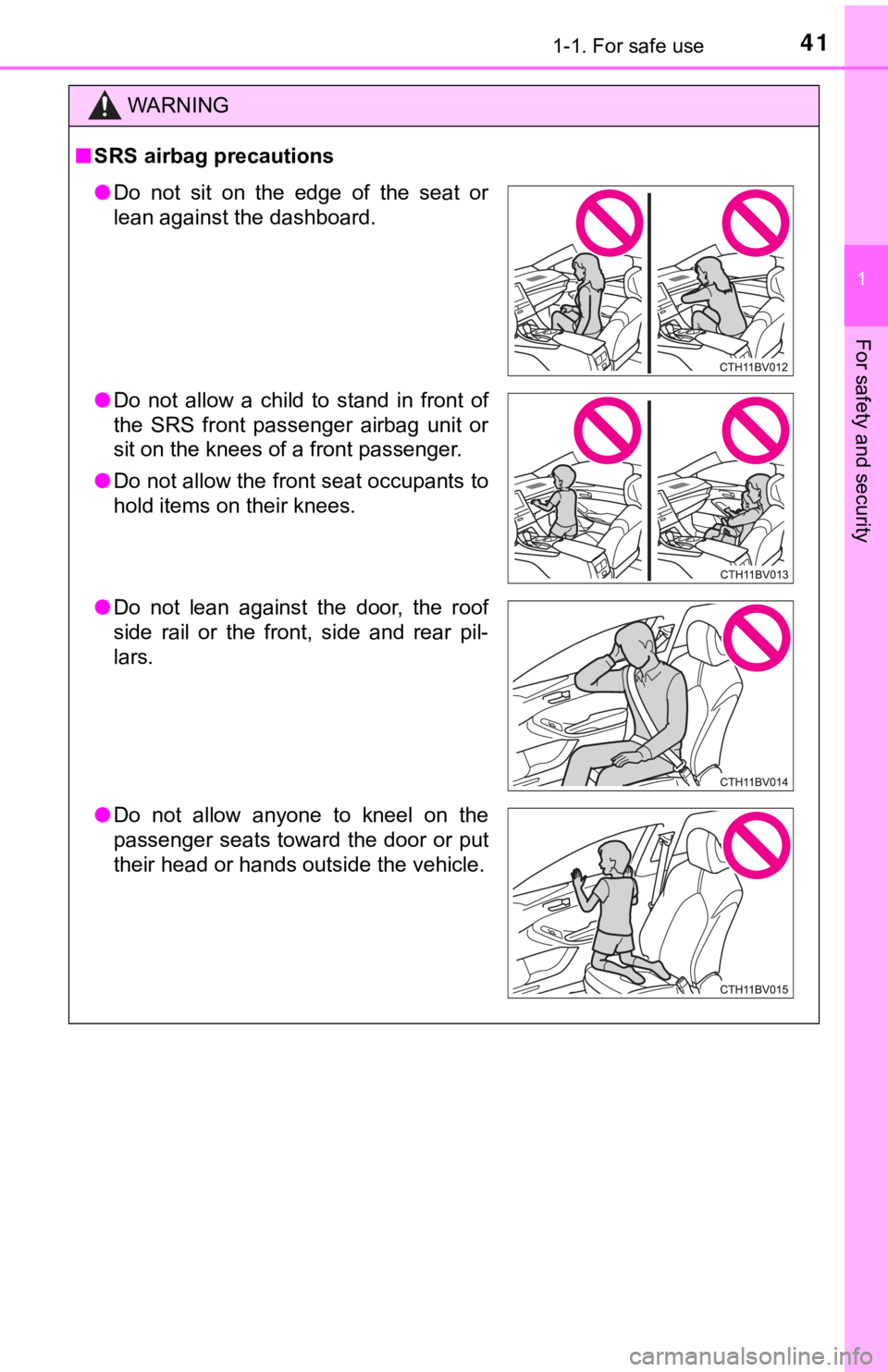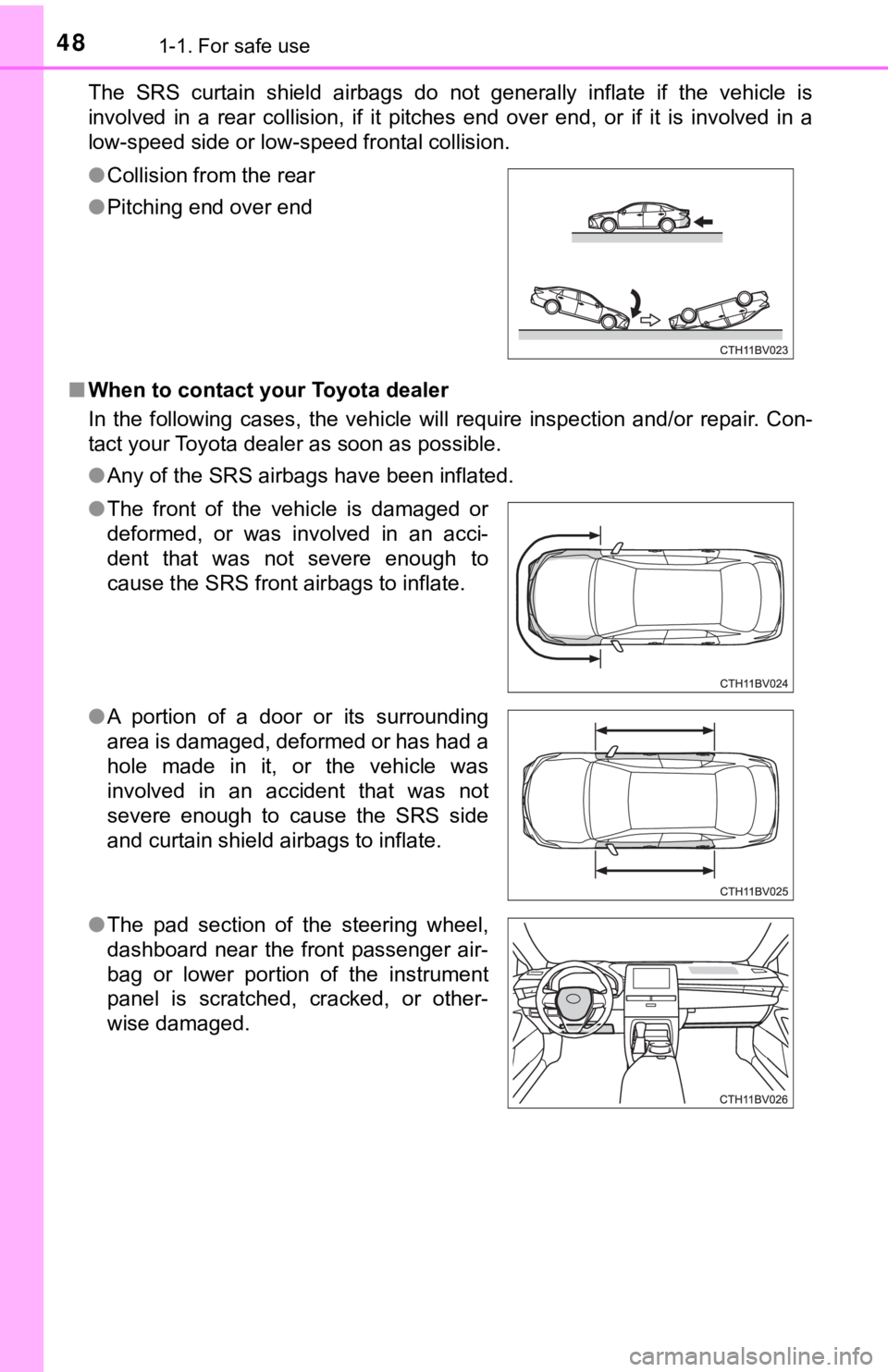dashboard TOYOTA AVALON 2021 Owners Manual (in English)
[x] Cancel search | Manufacturer: TOYOTA, Model Year: 2021, Model line: AVALON, Model: TOYOTA AVALON 2021Pages: 548, PDF Size: 13.4 MB
Page 41 of 548

411-1. For safe use
1
For safety and security
WARNING
â– SRS airbag precautions
â—ŹDo not sit on the edge of the seat or
lean against the dashboard.
â—ŹDo not allow a child to stand in front of
the SRS front passenger airbag unit or
sit on the knees of a front passenger.
â—ŹDo not allow the front seat occupants to
hold items on their knees.
â—ŹDo not lean against the door, the roof
side rail or the front, side and rear pil-
lars.
â—ŹDo not allow anyone to kneel on the
passenger seats toward the door or put
their head or hands outside the vehicle.
Page 44 of 548

441-1. For safe use
WARNING
â– Modification and disposal of SRS airbag system components
Do not dispose of your vehicle or perform any of the following modifications
without consulting your Toyota dealer. The SRS airbags may malfunction or
deploy (inflate) accidentally, causing death or serious injury.
â—Ź<002c0051005600570044004f004f00440057004c00520051000f0003005500480050005200590044004f000f00030047004c0056004400560056004800500045004f005c000300440051004700030055004800530044004c00550003005200490003005700
4b0048000300360035003600030044004c005500450044004a[s
â—ŹRepairs, modifications, removal or replacement of the steering wheel,
instrument panel, dashboard, seats or seat upholstery, front, side and rear
pillars, roof side rails, front door panels, front door trims or front door
speakers
â—ŹModifications to the front door panel (such as making a hole in it)
â—ŹRepairs or modifications of the front fender, front bumper, or side of the
occupant compartment
â—ŹInstallation of a grille guard (bull bars, kangaroo bar, etc.), snow plows,
winches, or roof luggage carrier
●Modifications to the vehicle’s suspension system
â—ŹInstallation of electronic devices such as mobile two-way radios and CD
players
â—ŹModifications to your vehicle for a person with a physical disability
Page 48 of 548

481-1. For safe use
The SRS curtain shield airbags do not generally inflate if the vehicle is
involved in a rear collision, if it pitches end over end, or if it is involved in a
low-speed side or low-speed frontal collision.
â– When to contact your Toyota dealer
In the following cases, the vehicle will require inspection and/or repair. Con-
tact your Toyota dealer as soon as possible.
â—ŹAny of the SRS airbags have been inflated. â—ŹCollision from the rear
â—ŹPitching end over end
â—ŹThe front of the vehicle is damaged or
deformed, or was involved in an acci-
dent that was not severe enough to
cause the SRS front airbags to inflate.
â—ŹA portion of a door or its surrounding
area is damaged, deformed or has had a
hole made in it, or the vehicle was
involved in an accident that was not
severe enough to cause the SRS side
and curtain shield airbags to inflate.
â—ŹThe pad section of the steering wheel,
dashboard near the front passenger air-
bag or lower portion of the instrument
panel is scratched, cracked, or other-
wise damaged.
Page 175 of 548

1754-1. Before driving
4
Driving
WARNING
Observe the following precautions.
Failure to do so may result in death or serious injury.
â– If you hear a squealing or scraping noise (brake pad wear limit indica-
tors)
Have the brake pads checked and replaced by your Toyota dealer as soon
as possible.
Rotor damage may result if the pads are not replaced when needed.
It is dangerous to drive the vehicle when the wear limits of the brake pads
and/or those of the brake discs are exceeded.
â– When the vehicle is stopped
â—ŹDo not race the engine.
If the shift lever is any position other than P or N, the vehicle may acceler-
ate suddenly and unexpectedly, causing an accident.
â—ŹIn order to prevent accidents due to the vehicle rolling away, always keep
depressing the brake pedal while the engine is running, and apply the
parking brake as necessary.
â—ŹIf the vehicle is stopped on an incline, in order to prevent accidents caused
by the vehicle rolling forward or backward, always depress the brake pedal
and securely apply the parking brake as needed.
â—ŹAvoid revving or racing the engine.
Running the engine at high speed while the vehicle is stopped may cause
the exhaust system to overheat, which could result in a fire if combustible
material is nearby.
â– When the vehicle is parked
â—ŹDo not leave glasses, cigarette lighters, spray cans, or soft drink cans in
the vehicle when it is in the sun.
Doing so may result in the following:
• Gas may leak from a cigarette lighter or spray can, and may lead to a
fire.
• The temperature inside the vehicle may cause the plastic lenses and
plastic material of glasses to deform or crack.
• Soft drink cans may fracture, causing the contents to spray over the
interior of the vehicle, and may also cause a short circuit in the vehicle’s
electrical components.
â—ŹDo not leave cigarette lighters in the vehicle. If a cigarette lighter is in a
place such as the glove box or on the floor, it may be lit accidentally when
luggage is loaded or the seat is adjusted, causing a fire.
â—ŹDo not attach adhesive discs to the windshield or windows. Do not place
containers such as air fresheners on the instrument panel or dashboard.
Adhesive discs or containers may act as lenses, causing a fire in the vehi-
cle.
Page 180 of 548

1804-1. Before driving
WARNING
â– Things that must not be carried in the trunk
<0037004b0048000300490052004f004f0052005a004c0051004a00030057004b004c0051004a0056000300500044005c0003004600440058005600480003004400030049004c005500480003004c00490003004f005200440047004800470003004c005100
030057004b004800030057005500580051004e001d[
â—ŹReceptacles containing gasoline
â—ŹAerosol cans
â– Storage precautions
Observe the following precautions.
Failure to do so may prevent the pedals from being depressed properly,
may block the driver’s vision, or may result in items hitting the driver or pas-
sengers, possibly causing an accident.
â—ŹStow cargo and luggage in the trunk whenever possible.
â—ŹTo prevent cargo and luggage from sliding forward during braking, do not
stack anything in the enlarged trunk. Keep cargo and luggage low, a s
close to the floor as possible.
â—ŹDo not place cargo or luggage in or on the following locations.
• At the feet of the driver
• On the front passenger or rear seats (when stacking items)
• On the package tray
• On the instrument panel
• On the dashboard
• Tray that has no lid
â—ŹSecure all items in the occupant compartment.
â—ŹWhen you fold down the rear seats, long items should not be placed
directly behind the front seats.
â—ŹNever allow anyone to ride in the enlarged trunk. It is not designed for pas-
sengers. They should ride in their seats with their seat belts properly fas-
tened.
â– Capacity and distribution
â—ŹDo not exceed the maximum axle weight rating or the total vehicle weight
rating.
●Even if the total load of occupant’s weight and the cargo load is less than
the total load capacity, do not apply the load unevenly. Improper loading
may cause deterioration of steering or braking control which may cause
death or serious injury.